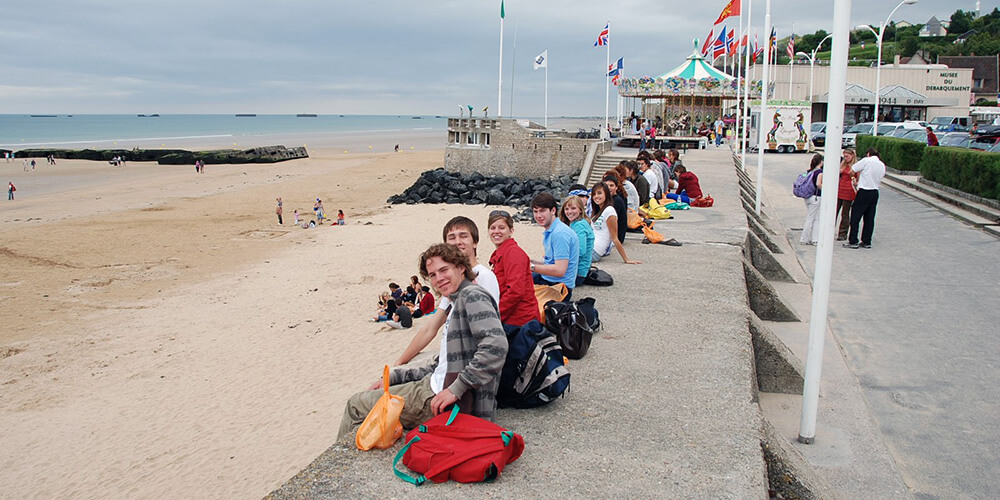This is the English translation of the blog post: Plages de débarquement, part of the 6-week journey of the international choral Harmonie en héritage.
The picture of the original post was taken at the beach of Arromanches. The black spots on the beach on the horizon are blocks of cement that are left of the temporary harbor that was built in only 8 days during the Normandy landing to bring supply to the troops on French soil. Saturday, August 1st was dedicated to the Normandy beaches.
Having asked Antoine what he thought of that day, Christine decided to have the teens share their experience over the microphone during the bus ride. So, Antoine from France along with one teen from Québec and one from Vermont shared their experience as follow:
From Antoine (France): “I loved our visit to the Canadian Museum at Juno Beach. In Normandy, we talk a lot about the Americans and British but I didn’t know that Canadians had also played such an important role during the landing. At Batterie de Longues, I liked placing myself in the canon and imagined how the soldiers felt hearing the bombing and being attacked by other soldiers. I really felt how they must have felt. The American cemetery in Colleville-Sur-Mer is very moving; you get a heavy feeling surrounded by a beautiful but sober setting with its white crosses, green grass, and ocean view.
We feel sad and thankful to the soldiers that rest here. We are here because of them.”
Chloé (Québec): Canadian Center at Juno Beach: “Knowing that Canada was also involved in the landing made me proud of my country. I didn’t know that they were so involved. I read as much as I could in the museum. I was touched by the letter from a Canadian soldier who was so affected by the Jewish prisoners that he was freeing from concentration camps. The American museum and cemetery: The museum is based more on the people and their sacrifice than on the war as was the Canadian museum. I went alone to the cemetery. It was a heavy feeling and I felt sadness. At the Batterie de Longues, I joined Antoine and felt the same fear when I was faced by the canon.”
Anna-Marie (Vermont): “At the Center in Juno Beach, I was hit by the beauty of the beach. At the museum, I was hit by the personal stories, the soldiers’ letters to their family. I didn’t feel any difference between the Americans and Canadians. I was simply proud of their common effort during the war. Before arriving at the American cemetery, knowing the importance of the location for Americans, I had a moment of silence. I wasn’t in France anymore; I felt I was in Washington DC, with a sense of pride and patriotism. I didn’t stay long in the museum; I just walked by myself in the cemetery. I never read so many names on the stones and I tried to think to each of them and had a silent thought for each of them … but soon I was faced with so many tombstones (over 9,000) that I started to cry. War kills love and life. I also saw the grave of the Ryan soldier, who inspired the movie “Saving Private Ryan”. I didn’t know it was a true story. Finally, The Batterie de Longues proved to me that time has continued to pass since the end of the war. Nature is back in its cornfields and poppies. This is a place that reminds you of the history that went on…”

